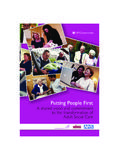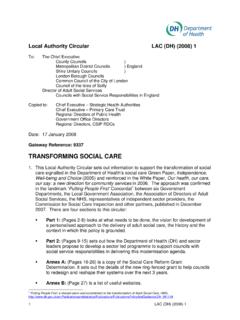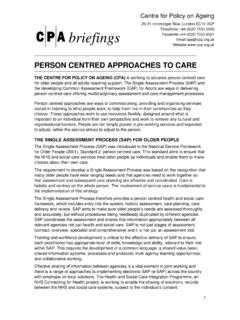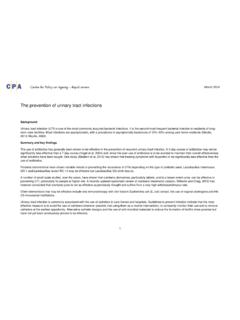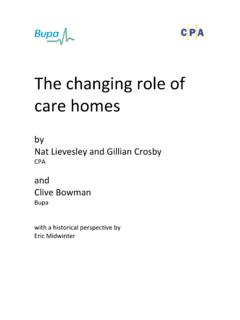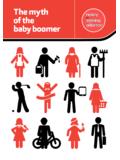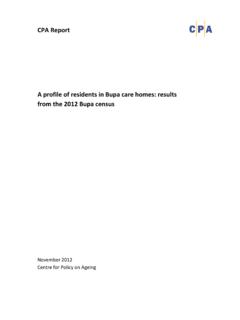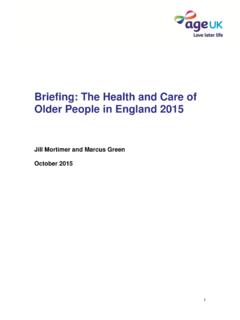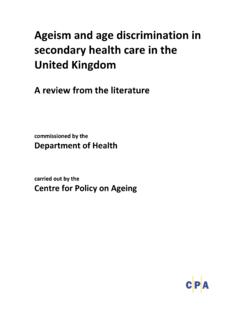Transcription of 25-31 Ironmonger Row, briefings
1 1 A REVIEW OF AGE DISCRIMINATION IN PRIMARY AND COMMUNITY HEALTH CARE, SECONDARY HEALTH CARE, MENTAL HEALTH CARE AND SOCIAL CARE SERVICES IN THE UNITED KINGDOM THE CENTRE FOR POLICY ON AGEING (CPA) carried out a series of five literature based reviews in 2007 and 2009, commissioned by the Department of Health, to look for evidence of age discrimination in health and social care services in the United Kingdom. The reviews looked at the costs and benefits of age discrimination legislation and at evidence of discrimination in primary and community health care, secondary health care, mental health care and social care. The CPA reviews support the Department of Health s activities to root out age discrimination in the context of the European Commission Draft Directive (July 2008) COM (2008) 426 and the introduction in the UK Parliament of the Equality Bill (April 2009) and related secondary legislation that will set out details of the new age discrimination ban in the provision of goods and services.
2 The body of work produced by CPA informed the national review on age discrimination, which brought together evidence from a range of sources to examine the extent to which health and social care services are differentiated by age, where people may receive less favourable treatment because of age, and where this may be unlawful and therefore constitute discrimination under the Equality Bill, culminating in a report to the Secretary of State for Health in October Key principles underpinning the work around age equality in health and social care include: unjustifiable age discrimination and unfair treatment based on age have no place in a fair society, which values all its members; personalisation means that meeting individuals needs for health and social care should be based on their individual condition and circumstances, not assumptions about their age; services should be differentiated by age only where this is beneficial and therefore objectively justifiable (see explanation below); 1 Achieving age equality in health and social care: A report to the Secretary of State for Health by Sir Ian Carruthers OBE and Jan Ormondroyd, October 2009.
3 briefings Centre for Policy on Ageing25-31 Ironmonger Row, London EC1V 3QP Telephone +44 (0)20 7553 6500 Facsimile +44 (0)20 7553 6501 Email Website 2 services should demonstrate value and beneficial outcomes for all people in the use of public funds. The Equality Bill The Equality Bill creates a single public sector equality duty, covering eight protected characteristics: age, disability, gender reassignment, pregnancy or maternity, race, religion or belief, sex, and sexual orientation. It establishes that discrimination is about relative rather than absolute standards. Discrimination law is about a person s treatment relative to that of a comparator (except pregnancy and maternity) including a hypothetical comparator (except equal pay), not about absolute standards. Direct discrimination is treating someone less favourably because of a protected characteristic.
4 This does not have to be the victim s own characteristic: association and perception are also covered. Indirect discrimination is applying to someone a provision, criterion or practice which puts them, and persons with whom they share a protected characteristic, at a particular disadvantage. When assessing evidence of discrimination it is important to be clear that disadvantageous discrimination that would otherwise be indirect discrimination (for any protected characteristic), and less favourable treatment that would otherwise be direct discrimination (for age only) is not discrimination if the person applying it can show it to be a proportionate means of achieving a legitimate aim (also referred to as objective justification ). Ageism and age discrimination The CPA reviews distinguished between ageism, a term first used in the late 1960s to describe an unjustifiable prejudicial attitude of mind towards older people, and age discrimination, discriminatory actions, made purely on the basis of age that can be observed and, perhaps, measured.
5 Age discrimination can occur in a variety of ways. Direct age discrimination treats two individuals with similar needs differently purely on the basis of their age. Indirect age discrimination treats people of all ages the same, not recognising the greater needs of particular age groups so those age groups are disadvantaged. Institutional age discrimination is age discrimination written into policies and practice. Individual age discrimination is discriminatory action taken by individuals as a result of their own personal ageist attitudes. Overt age discrimination is age discrimination that is open and observable. Covert age discrimination is hidden and possibly even subconscious. Institutional age discrimination is likely to be overt. Individual age discrimination is likely to be covert. Age differentiated behaviour is a well thought out and justifiable difference in treatment by age based on a well developed understanding of age differences.
6 Age discrimination in policy The audit by the Healthcare Commission (2006) found that explicit age discrimination in policy has declined since the National Service Framework for Older People was introduced in 2001. The key exceptions are age cut-offs in screening programmes by invitation, the age based organisation and provision of mental health services, the age based organisation and provision of social care services and, arguably, the National Institute of Health and Clinical Excellence s (NICE) use of the Quality Adjusted Life Year (QALY) in assessing the overall relative cost effectiveness of treatments that are only or mainly of benefit to older people. Although not strictly part of health and social care, related benefit payments such as 3 Attendance Allowance, Disability Living Allowance and Independent Living Funds have age-based cut-offs in their application which may conflict with age discrimination legislation.
7 Sreening programmes One of the most explicit forms of age discrimination in healthcare in the NHS is the upper age limit on some screening programmes by invitation, not indicated by disease prevalence or other clinical indicator. Upper age limits currently exist of 69 for breast and bowel cancer screening and 64 for cervical screening by routine invitation. Women from 50-70 are routinely invited to breast screening; once women reach the upper age limit for routine invitations for breast screening, they are encouraged to make their own appointment. The research shows that breast and cervical screening offer the most benefit and that extending breast screening to the age of 74 would be more effective than cervical screening at any age. It also indicated that cervical screening policy should be extended to the age of 69 because more lives are lost to cervical cancer among women in their 70s than among women under 30.
8 Many more older women attend screening following an invitation than had previously self-referred and cancer detection rate is higher in the 65-70 group than in the 60-64 group. The UK's national bowel screening programme has an age span of 60-69 although there are plans to extend this to 75 at the end of 2010; people outside the upper age limit have to be highly proactive and request a screening kit by telephone. There is no clear evidential base for the upper age limit in the bowel screening programme. The new UK vascular screening programme for 40-74 year olds was launched in April 2009. The upper age limit has been capped at 74, which excludes a large number of people who may benefit as vascular problems intensify with age. To prevent stroke, it is important to ensure that hypertension is also controlled in people over 75, the age group which has the most strokes.
9 Quality Adjusted Life Years (QALY) There is divided opinion over whether the QALY, the primary measure by which the National Institute for Health and Clinical Excellence (NICE) assesses the cost effectiveness of procedures and treatments, is inherently age discriminatory. There is a strong suspicion that, no matter how it is packaged, the use of Quality Adjusted Life Years to assess the relative cost effectiveness of treatments and procedures will discriminate against those procedures and treatments, for example for Alzheimer s disease, osteoarthritis, osteoporosis or macular degeneration, that are mainly beneficial to older people with few remaining years. Frail, older people with co morbidities may be particularly disadvantaged as successful treatment of one aspect of ill health will be less effective in terms of overall health benefit.
10 It is however argued that, on the contrary, treatments provided on a pay-as-you-go basis, without large up-front costs, have the same marginal cost / benefit trade-offs at any age. Organisation of mental health and social care services There is widespread variation in the way in which mental health services for older people are organised but, in most areas there are separate adult and older people s services with, in many areas, transfer between the services at age 65. One third of authorities do not have transition protocols in place and levels of provision are less good in older people s mental 4 health services for graduates who transfer between services with a continuing mental health problem. The exception to this decline in explicit discrimination is mental health services where the organisational division between mental health services for adults of working age and older people has resulted in the development of an unfair system, as the range of services available differs for each of these groups.
